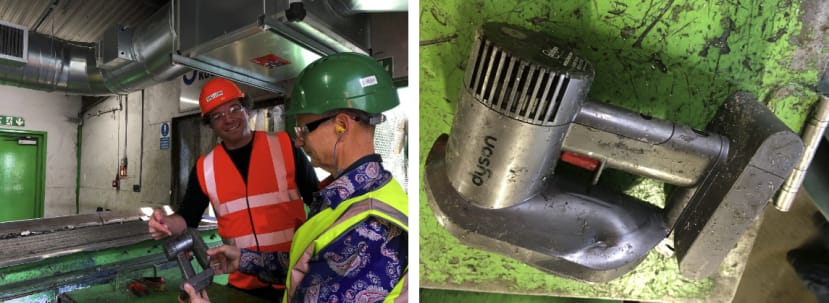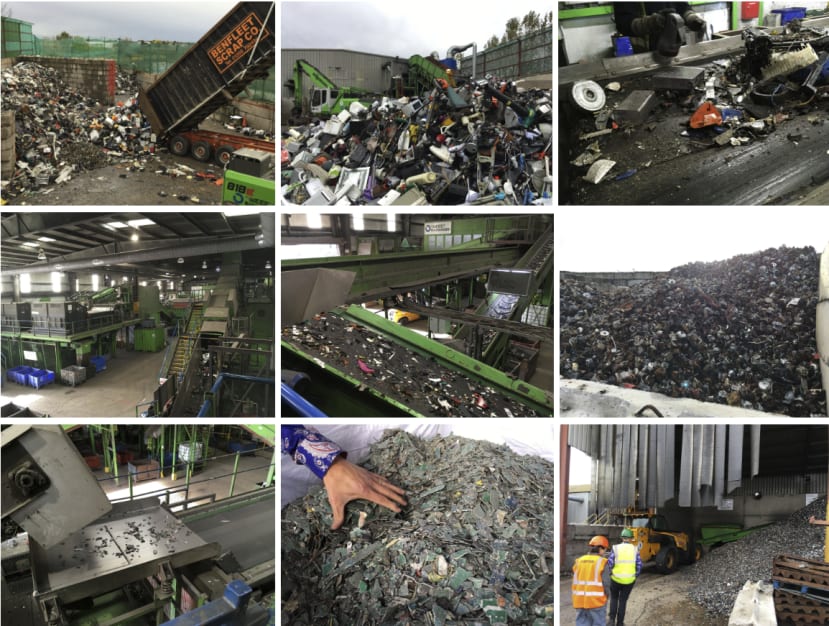The Fight to Repair - Part 8: End of Life, Dyson Recycling, HypnoCat and SWEEEP Kuusakoski.
Follow articleHow do you feel about this article? Help us to provide better content for you.
Thank you! Your feedback has been received.
There was a problem submitting your feedback, please try again later.
What do you think of this article?
I ventured to Sittingbourne just southwest of London, for a 4 hour visit to a processing plant for electrical appliances, where microwaves, TVs, Vacuums are ‘shredded’ in a giant blender to reclaim precious metals, minerals and compounds.
As part of a series of articles, this one will focus on:
- After researching the importance of good design of portable electronic devices, I still hadn’t actually seen what happens to old electrical appliances. Turns out the UK’s largest processing plant was only a 2 hour train ride away!
- I was given a tour around SWEEEP Kuusakoski, to give context to the need to make batteries easy to separate at end of life. (Even if replaceable in use). This informed many more tips for designers and engineers, as well as raising awareness of the ecosystem of recovering minerals and chemicals being a ‘last resort’ for consumers.
- Essential viewing, and perhaps even a visit is needed for progressive companies (they’ve had some big names in design already!).
An unforgattable technical site visit...
One of the most interesting ‘site visits’ I’ve been on in a while! SWEEEP Kuusakoski[ "koo-sa-kosk-ee" ] was actually a recommendation from Andrew Carr, as he’d been before and was hugely impressed.
Having worked in the business of communicating tech to a wide range of people, I was initially in stitches watching the Hypnocat video on a cat that wanted to ‘encourage’ you to recycle your appliances - properly (not just ‘leave by the bins and pray’). To make this not only funny, but also very accurate is a rare thing. The video is a great example of ‘education by stealth’, as it has a surprisingly dense amount of information , between the absurdity of the feline narrator.
As mentioned in the Prologue, I was humbled to see a Dyson DC34 handheld vacuum cleaner (the first battery powered cleaner of its kind by the company) at the processing plant. It is worth saying again, that to see something you’ve had a hand in designing, some 14 years ago, now in your hands at ‘End-of-Life’ is oddly profound, and drives home your responsibility for making choices in design.
If we’d assume that the ‘idealism of youth’ is a fair stereotype, this can at times feel naive in the face of commercial goals, making sustainable design a tense negotiation of ‘desirability, feasibility and viability’. This is not to imply the ‘old guard’ in a company don’t want change, but more that they are the ones where the buck actually stops - in terms of compliance, lawsuits, reputation, PR chaos, and much more. It’s often easier to be gung-ho when you have less to lose.
However, having been around long enough to have a taste of responsibility and pressure, as well as the earnestness of virtues - I can say that often the best result is a marriage of the two. Frankly, when you’re young you don’t ‘have the chops’ to do half the things you dream of doing. But as you get more experiences, it can indeed be tempting to rest on laurels, and play safe - it’s not easy to risk everything, especially when you are likely supporting more than a beer-and-pizza lifestyle at mid-life/career!
I personally find that positioning your younger idealistic people as a ‘Court Jester’ is a powerful strategy. Granted it requires a little humility to be ‘cast’ in such a role, as it essentially doubles-down on the seemingly preposterous naivety of youth (better they are ‘in’ on the strategy, than feel ridiculed). However, the manager is there to ‘curb their enthusiasm’, in what actually results is a raising of ambitions, as by ‘reigning in’ some of the lofty goals, the core ‘truth’ is often retained. If the manager had begun with what is ‘reasonable’, it would still be ‘dialled back’, and would arguably be so unambitious as to be out of date by the time it hits the market!
As they say - “Aim for the stars and you’ll perhaps get to the Moon” (implying if you aim for the Moon to begin, you won’t reach anything significant). So the young turks are the Stars, in fact. And yes, the older guard is gonna get this thing to the Moon.
Whilst experience can sometimes lead to a certain degree of conservatism, there are also those who are incredibly well connected in a company, and wield considerable power, and frankly see their last decade as a fearless ‘swan song’, or ‘one last dance’, and so they’re are somewhat fearless and staggeringly powerful in driving change through. Arguably this is the Gandalf x Frodo combination of vigour/ideals and wisdom/power. And yes, to extend the Lord of The Rings metaphor to breaking point, I do think most teams doing radical innovation resemble a ‘rebel force’, be it a Fellowship, A-Team or motley crew - the best have a diversity of skills and experience.
Getting back to the SWEEEP recycling centre, I think the preamble of leadership and teamwork is essential if you intend to visit SWEEEP, or some place like it. It is more likely than not those who venture outside of the company are the ‘troublemakers’ and ‘visionaries’ and ‘new blood’, so I say this with a self-awareness, that returning to the ‘mothership’ and enthusiastically presenting to the wider team may well be ‘inspirational’, but like a TED Talk, the real work is finding how this make sense for your company’s own journey with Sustainability.
Framing is a key thing, as above we have pretty much the exact same raw film footage, but rather than a crazy Hypnocat, this is a more subtle, serious and authoritative video for the Design Museum.
Different strokes for different folks...
So when exploring a place like this try to consider what your company is struggling with, and what is the potential to create the best story. For example, if you’re working in a young company, it’s likely you can be more ‘outraged’ and ‘earnest’ about the urgency of the matter, and this is powerful footage to show the staggering decadence of consumerism and why creating more cherished products is likely in line with your target market.
Taking a more established company, the ‘pitch’ will likely need to be more nuanced. You may well need to focus on the ‘pain’ of what legislation, taxes, back-lashes, falling-behind, etc. - will mean for the brands and company profits. As Andrew Carr has said in a previous interview with ProtoLabs “Even a Sustainable Business needs to be Sustainable” - meaning it needs to be solvent, and keep going, else what’s the point. So a compromise is very necessary and not all things can be done on day 1.
To balance the ‘threat’, (think SWOT), one can then highlight the opportunities, and depending on the nature of the products made, one can explore how the consumer may benefit, or be more loyal to a brand or accessories (repairable parts, upgrades, spares, extras, etc.). If you consider a car company makes almost as much on repairs and maintenance as it does selling a car, ‘repairability’ need not be a loss-making strategy. Granted one should not ‘play dirty’ to create planned obsolescence games or CO2 offset manoeuvres, but there may well be new business models which are worth the pivot in strategy and the re-designs needed to realise it.
Lastly, it must also be said that if your company is in the game of ‘hiring the best talent’, this usually means ‘young’, and so these ‘virtues’ are coming. Like it or not. It may be tempting to be a ‘fast follower’, but this does not usually get you the best talent, and hence the slow decline may be starting, even if it is hard to detect at first... So yet again, I return to the ‘Young + Older’ model, and the common theme is being open to the change, but pragmatic, persistent, and patient about the realisation of it. The extension of that being to build alliances with others with different skills and capabilities, or where the alliance/partnership allows you both a unique mutual win.
I hope you get to visit a place like SWEEEP, and take back a vast collection of photos, pictures and statistics - but the work will begin in understanding what the narrative is for your company. Ideally spending some time preparing for this, whilst still being open to a revelation once there, seems like a good approach. Good luck being inspired to do better.
And indeed, if you’d like help with this sort of strategic positioning, R&D prioritisation, and storytelling (combined with technical expertise) for Sales and Marketing, please do get in touch (link)!
Up Next...
Contents:
Prologue:
Pre-Departure Notice -How an Attempt to Repair my Headphones Turned into a 3-Month Journey with a Grand Finale at the Recycling Centre.
Main Articles:
Intro - The Fight to Repair with Jude Pullen, for RS DesignSpark.
Part 1 - LiPo Battery Basics, Headless Laptops & Safety First.
Part 2 - Returning to Hong Kong, My Design Conspiracy Theories and Meeting Dr Lawrence.
Part 3 - Falling in Love With The Problem of R2R, Looria, and Pre-Purchase Reparability Considerations.
Part 4 - Ken Pillonel’s Ingenious iPhone Hack, and Repairability as a Disruptor.
Part 5 - Battery Post-Mortems with Andy Sinclair, Vapes, Dogmatism and Hacking My Headphones.
Part 6 - Legislation Loopholes, Eco Black Mirror, Chunky Fashion, and R2R Business Models and The Case for Standardisation.
Part 7 - Design, Engineering & Electronics Recommendations for R2R.
Encore:
Part 8 - Visit to End of Life Processing Plant - SWEEEP Kuusakoski Ltd
Part 9 - Interviews with Industry Experts on Right to Repair.
Contact: If you have any other questions, or would like to collaborate, please get in touch (link).
Disclaimer: This series has been created for discussion purposes and is not a 'how to' guide. Jude Pullen is a chartered engineering professional, and has sought additional expert advice alongside his endeavours to explore this subject safely. For additional information please see DS Terms of Use.




